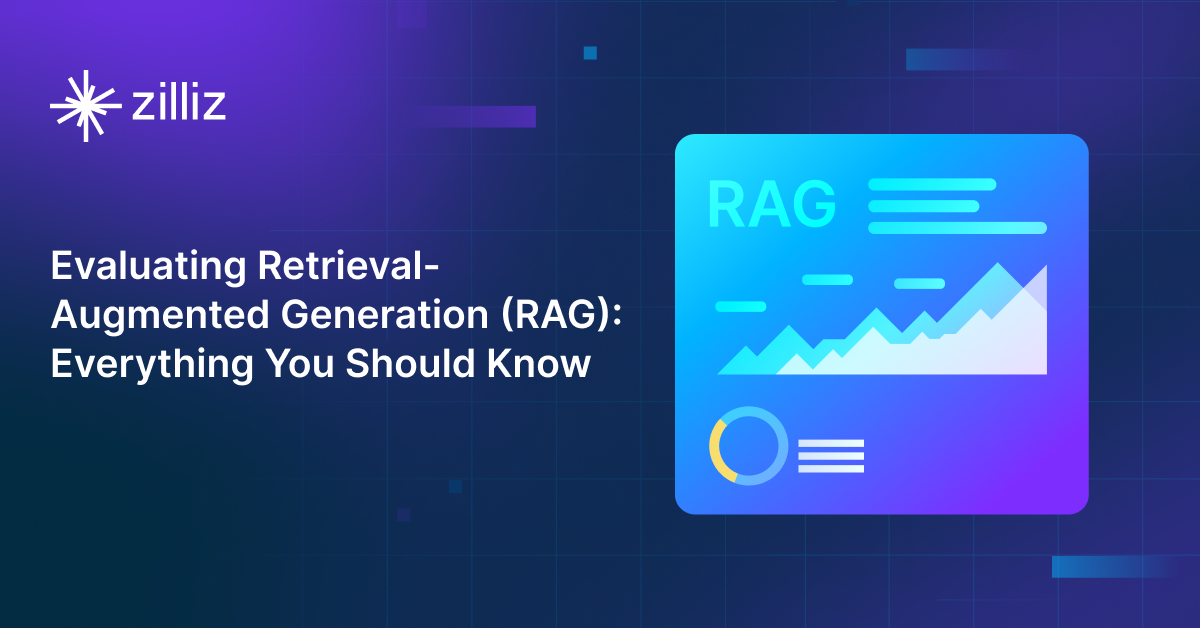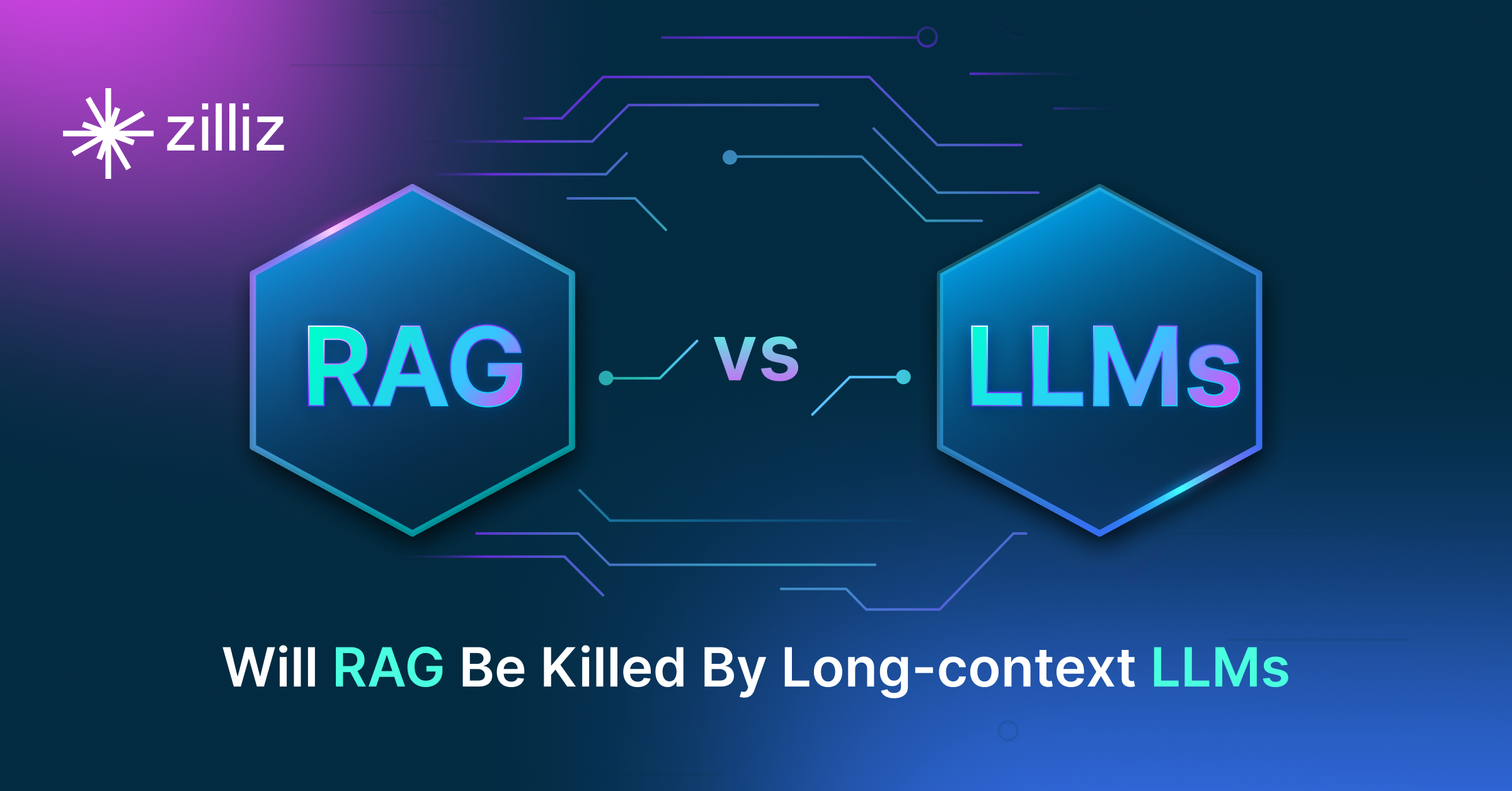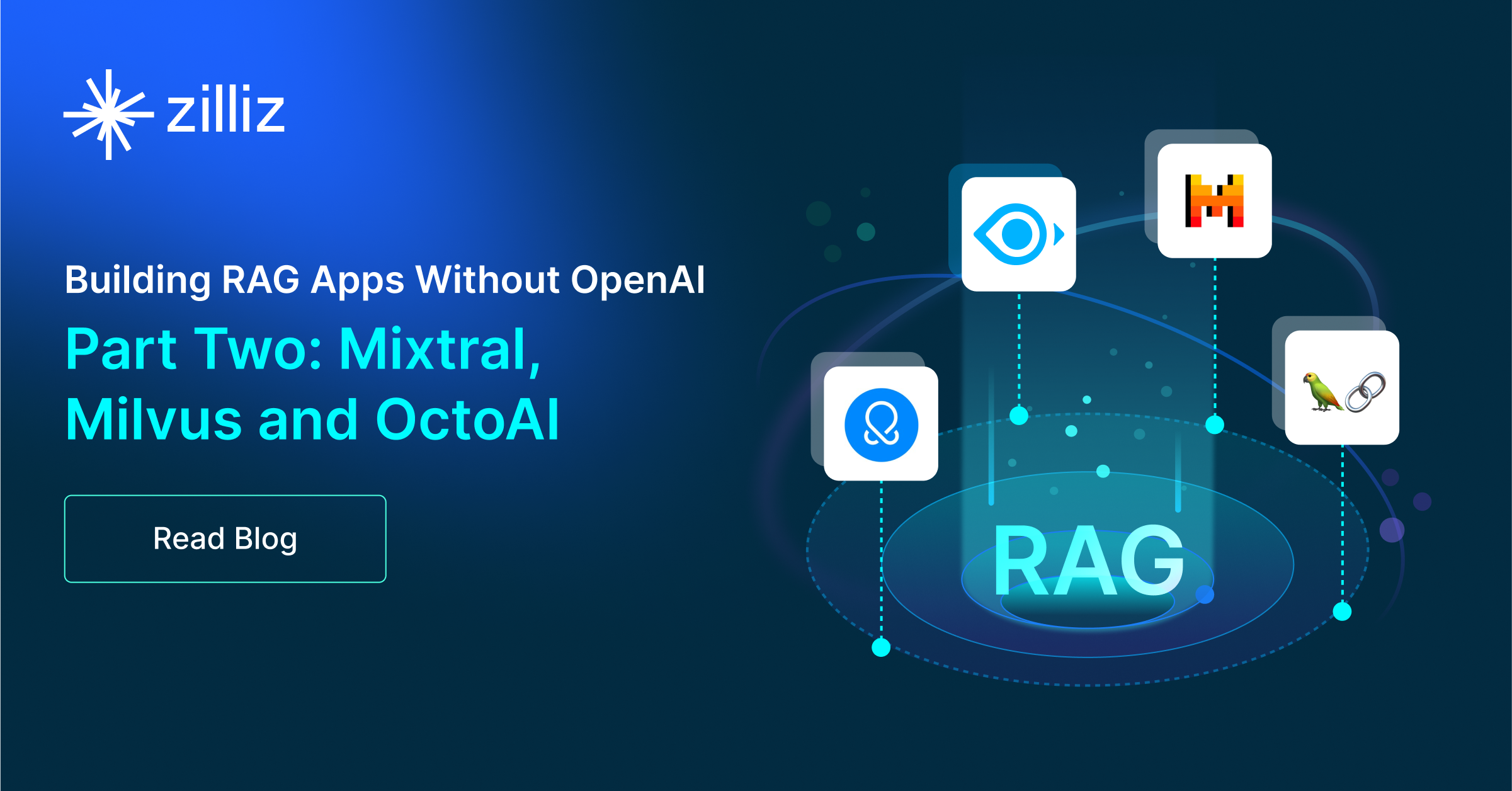Build RAG Chatbot with LangChain, LangChain vector store, Mistral AI Mistral 7B, and IBM all-minilm-l12-v2
Introduction to RAG
Retrieval-Augmented Generation (RAG) is a game-changer for GenAI applications, especially in conversational AI. It combines the power of pre-trained large language models (LLMs) like OpenAI’s GPT with external knowledge sources stored in vector databases such as Milvus and Zilliz Cloud, allowing for more accurate, contextually relevant, and up-to-date response generation. A RAG pipeline usually consists of four basic components: a vector database, an embedding model, an LLM, and a framework.
Key Components We'll Use for This RAG Chatbot
This tutorial shows you how to build a simple RAG chatbot in Python using the following components:
- LangChain: An open-source framework that helps you orchestrate the interaction between LLMs, vector stores, embedding models, etc, making it easier to integrate a RAG pipeline.
- LangChain in-memory vector store: an in-memory, ephemeral vector store that stores embeddings in-memory and does an exact, linear search for the most similar embeddings. The default similarity metric is cosine similarity, but can be changed to any of the similarity metrics supported by ml-distance. It is intended for demos and does not yet support ids or deletion. (If you want a much more scalable solution for your apps or even enterprise projects, we recommend using Zilliz Cloud, which is a fully managed vector database service built on the open-source Milvusand offers a free tier supporting up to 1 million vectors.)
- Mistral AI's Mistral 7B: A highly efficient and powerful language model with 7 billion parameters. It is designed to offer robust performance for a wide range of natural language processing tasks, delivering high-quality responses while maintaining a balance between speed and computational resource usage. Its architecture is optimized for both flexibility and scalability in AI applications.
- IBM all-minilm-l12-v2: This model is a compact yet powerful transformer-based architecture optimized for natural language understanding and processing tasks. It excels in scenarios requiring efficient computation without sacrificing performance, making it ideal for applications in chatbots, information retrieval, and sentiment analysis. Its lightweight design enables integration in resource-constrained environments while maintaining competitive accuracy.
By the end of this tutorial, you’ll have a functional chatbot capable of answering questions based on a custom knowledge base.
Note: Since we may use proprietary models in our tutorials, make sure you have the required API key beforehand.
Step 1: Install and Set Up LangChain
%pip install --quiet --upgrade langchain-text-splitters langchain-community langgraph
Step 2: Install and Set Up Mistral AI Mistral 7B
pip install -qU "langchain[mistralai]"
import getpass
import os
if not os.environ.get("MISTRAL_API_KEY"):
os.environ["MISTRAL_API_KEY"] = getpass.getpass("Enter API key for Mistral AI: ")
from langchain.chat_models import init_chat_model
llm = init_chat_model("open-mistral-7b", model_provider="mistralai")
Step 3: Install and Set Up IBM all-minilm-l12-v2
pip install -qU langchain-ibm
import getpass
import os
if not os.environ.get("WATSONX_APIKEY"):
os.environ["WATSONX_APIKEY"] = getpass.getpass("Enter API key for IBM watsonx: ")
from langchain_ibm import WatsonxEmbeddings
embeddings = WatsonxEmbeddings(
model_id="sentence-transformers/all-minilm-l12-v2",
url="https://us-south.ml.cloud.ibm.com",
project_id="<WATSONX PROJECT_ID>",
)
Step 4: Install and Set Up LangChain vector store
pip install -qU langchain-core
from langchain_core.vectorstores import InMemoryVectorStore
vector_store = InMemoryVectorStore(embeddings)
Step 5: Build a RAG Chatbot
Now that you’ve set up all components, let’s start to build a simple chatbot. We’ll use the Milvus introduction doc as a private knowledge base. You can replace it with your own dataset to customize your RAG chatbot.
import bs4
from langchain import hub
from langchain_community.document_loaders import WebBaseLoader
from langchain_core.documents import Document
from langchain_text_splitters import RecursiveCharacterTextSplitter
from langgraph.graph import START, StateGraph
from typing_extensions import List, TypedDict
# Load and chunk contents of the blog
loader = WebBaseLoader(
web_paths=("https://milvus.io/docs/overview.md",),
bs_kwargs=dict(
parse_only=bs4.SoupStrainer(
class_=("doc-style doc-post-content")
)
),
)
docs = loader.load()
text_splitter = RecursiveCharacterTextSplitter(chunk_size=1000, chunk_overlap=200)
all_splits = text_splitter.split_documents(docs)
# Index chunks
_ = vector_store.add_documents(documents=all_splits)
# Define prompt for question-answering
prompt = hub.pull("rlm/rag-prompt")
# Define state for application
class State(TypedDict):
question: str
context: List[Document]
answer: str
# Define application steps
def retrieve(state: State):
retrieved_docs = vector_store.similarity_search(state["question"])
return {"context": retrieved_docs}
def generate(state: State):
docs_content = "\n\n".join(doc.page_content for doc in state["context"])
messages = prompt.invoke({"question": state["question"], "context": docs_content})
response = llm.invoke(messages)
return {"answer": response.content}
# Compile application and test
graph_builder = StateGraph(State).add_sequence([retrieve, generate])
graph_builder.add_edge(START, "retrieve")
graph = graph_builder.compile()
Test the Chatbot
Yeah! You've built your own chatbot. Let's ask the chatbot a question.
response = graph.invoke({"question": "What data types does Milvus support?"})
print(response["answer"])
Example Output
Milvus supports various data types including sparse vectors, binary vectors, JSON, and arrays. Additionally, it handles common numerical and character types, making it versatile for different data modeling needs. This allows users to manage unstructured or multi-modal data efficiently.
Optimization Tips
As you build your RAG system, optimization is key to ensuring peak performance and efficiency. While setting up the components is an essential first step, fine-tuning each one will help you create a solution that works even better and scales seamlessly. In this section, we’ll share some practical tips for optimizing all these components, giving you the edge to build smarter, faster, and more responsive RAG applications.
LangChain optimization tips
To optimize LangChain, focus on minimizing redundant operations in your workflow by structuring your chains and agents efficiently. Use caching to avoid repeated computations, speeding up your system, and experiment with modular design to ensure that components like models or databases can be easily swapped out. This will provide both flexibility and efficiency, allowing you to quickly scale your system without unnecessary delays or complications.
LangChain in-memory vector store optimization tips
LangChain in-memory vector store is just an ephemeral vector store that stores embeddings in-memory and does an exact, linear search for the most similar embeddings. It has very limited features and is only intended for demos. If you plan to build a functional or even production-level solution, we recommend using Zilliz Cloud, which is a fully managed vector database service built on the open-source Milvus and offers a free tier supporting up to 1 million vectors.)
Mistral AI Mistral 7B optimization tips
Mistral 7B is a dense transformer-based model optimized for efficiency, making it a strong choice for RAG applications with constrained resources. Improve retrieval by using high-quality embeddings and reranking strategies to ensure only the most relevant documents are included in the context window. Optimize token usage by structuring input prompts concisely, eliminating redundant details while preserving key information. Use temperature (0.1–0.3) for consistent factual accuracy and adjust sampling techniques based on the required response diversity. Deploy Mistral 7B in a scalable infrastructure by leveraging quantization techniques (such as 4-bit or 8-bit precision) to improve inference speed without significantly impacting accuracy. Implement batch processing for handling multiple queries efficiently, reducing overall computational load. When working in real-time applications, consider response caching to minimize redundant API calls.
IBM all-minilm-l12-v2 optimization tips
To optimize the IBM all-minilm-l12-v2 model in a Retrieval-Augmented Generation (RAG) setup, consider fine-tuning it on domain-specific datasets to enhance relevance and accuracy for your particular use case. Implement model distillation techniques to reduce inference time while maintaining performance. Additionally, ensure efficient batch processing by adjusting the maximum sequence length based on your input data, and utilize mixed precision training to improve computational efficiency. Regularly evaluate the model's performance with various retrieval methods to identify the best combination and consider employing caching strategies for frequently accessed data to minimize latency. Finally, experiment with different hyperparameters, like learning rate and dropout rates, during fine-tuning to achieve optimal results.
By implementing these tips across your components, you'll be able to enhance the performance and functionality of your RAG system, ensuring it’s optimized for both speed and accuracy. Keep testing, iterating, and refining your setup to stay ahead in the ever-evolving world of AI development.
RAG Cost Calculator: A Free Tool to Calculate Your Cost in Seconds
Estimating the cost of a Retrieval-Augmented Generation (RAG) pipeline involves analyzing expenses across vector storage, compute resources, and API usage. Key cost drivers include vector database queries, embedding generation, and LLM inference.
RAG Cost Calculator is a free tool that quickly estimates the cost of building a RAG pipeline, including chunking, embedding, vector storage/search, and LLM generation. It also helps you identify cost-saving opportunities and achieve up to 10x cost reduction on vector databases with the serverless option.
 Calculate your RAG cost
Calculate your RAG cost
What Have You Learned?
By now, you’ve unlocked the magic of building a RAG system from the ground up! You’ve seen how LangChain acts as the glue, seamlessly connecting your pipeline’s components—like a conductor orchestrating a symphony. Mistral 7B, with its powerhouse ability to generate human-like text, becomes your creative engine, while IBM’s all-minilm-l12-v2 embedding model transforms messy data into crisp, searchable vectors. Pair that with LangChain’s vector store, and suddenly your system can retrieve relevant information lightning-fast, like a librarian who always knows exactly where to find the right book. But it’s not just about slapping parts together—you’ve learned to optimize, tweaking parameters and chunking strategies to balance speed, accuracy, and cost (shoutout to that free RAG cost calculator for keeping budgets in check!).
You’re now armed with the tools to turn raw data into dynamic, intelligent applications. Imagine chatbots that don’t just parrot answers but understand context, or research tools that surface insights in seconds. The best part? You’ve got a playbook for innovation. Whether you’re scaling up with Mistral’s efficiency or experimenting with hybrid retrieval tactics, the sky’s the limit. So go ahead—dive in, experiment, and watch your ideas come alive. The future of AI is yours to shape, one RAG-powered breakthrough at a time. Let’s build something unforgettable! 🚀
Further Resources
🌟 In addition to this RAG tutorial, unleash your full potential with these incredible resources to level up your RAG skills.
- How to Build a Multimodal RAG | Documentation
- How to Enhance the Performance of Your RAG Pipeline
- Graph RAG with Milvus | Documentation
- How to Evaluate RAG Applications - Zilliz Learn
- Generative AI Resource Hub | Zilliz
We'd Love to Hear What You Think!
We’d love to hear your thoughts! 🌟 Leave your questions or comments below or join our vibrant Milvus Discord community to share your experiences, ask questions, or connect with thousands of AI enthusiasts. Your journey matters to us!
If you like this tutorial, show your support by giving our Milvus GitHub repo a star ⭐—it means the world to us and inspires us to keep creating! 💖
- Introduction to RAG
- Key Components We'll Use for This RAG Chatbot
- Step 1: Install and Set Up LangChain
- Step 2: Install and Set Up Mistral AI Mistral 7B
- Step 3: Install and Set Up IBM all-minilm-l12-v2
- Step 4: Install and Set Up LangChain vector store
- Step 5: Build a RAG Chatbot
- Optimization Tips
- RAG Cost Calculator: A Free Tool to Calculate Your Cost in Seconds
- What Have You Learned?
- Further Resources
- We'd Love to Hear What You Think!
Content
Vector Database at Scale
Zilliz Cloud is a fully-managed vector database built for scale, perfect for your RAG apps.
Try Zilliz Cloud for Free


